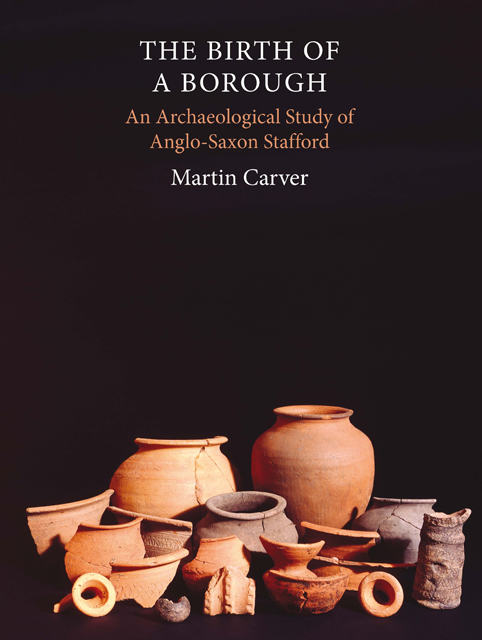Book contents
- Frontmatter
- Contents
- List of Illustrations
- Preface
- Acknowledgements
- Abbreviations
- 1 Questions
- 2 Digging up Stafford: Evaluation and Design
- 3 Seven Windows on Early Stafford: The Principal Investigations
- 4 Æthelflæd’s Town
- 5 Aftermath: Norman and Medieval Stafford
- 6 Anglo-Saxon Stafford in Context
- Digest A1 Archaeological Interventions at Stafford to 1988
- Digest A2 Dendrochronological and Radiocarbon Dates
- Digest A3 Pottery Seriation
- Digest A4 Key to Pottery Illustrations
- Digest A5 Excavated Structures
- Digest A6 Contents of the Stafford Online Archive: http://ads.ahds.ac.uk/catalogue/archive/stafford_eh_2009
- Bibliography
- Index
2 - Digging up Stafford: Evaluation and Design
Published online by Cambridge University Press: 17 February 2023
- Frontmatter
- Contents
- List of Illustrations
- Preface
- Acknowledgements
- Abbreviations
- 1 Questions
- 2 Digging up Stafford: Evaluation and Design
- 3 Seven Windows on Early Stafford: The Principal Investigations
- 4 Æthelflæd’s Town
- 5 Aftermath: Norman and Medieval Stafford
- 6 Anglo-Saxon Stafford in Context
- Digest A1 Archaeological Interventions at Stafford to 1988
- Digest A2 Dendrochronological and Radiocarbon Dates
- Digest A3 Pottery Seriation
- Digest A4 Key to Pottery Illustrations
- Digest A5 Excavated Structures
- Digest A6 Contents of the Stafford Online Archive: http://ads.ahds.ac.uk/catalogue/archive/stafford_eh_2009
- Bibliography
- Index
Summary
History of the investigations
Stafford today is a busy urban place (Fig. 2.1) with shopping precincts, car parks and the headquarters of the municipality and the county. In 1975 it was under construction, a late-comer to the boom of the 1960s that had refashioned so many historic town centres and shocked the archaeological community into its ‘rescue’ response. Since it was only then beginning its redevelopment programme, large areas of Stafford lay open in 1975, unencumbered by buildings and awaiting planning decisions. There had been only one archaeological research investigation, the opening of a small area on the site of St Bertelin's church outside the west front of St Mary’s, Stafford's principal church. The excavator, Adrian Oswald of Birmingham City Museum, decided he had found St Bertelin's chapel and its predecessors, together with a lump of wood six foot long, which was interpreted as a wooden cross of the early Mercian period. The footings of the medieval chapel and a reconstruction of the early medieval ‘cross’ remain on display to this day (Fig. 2.2). Oswald's interpretation was made in the natural expectation that Stafford should have an early Anglo-Saxon church – as indeed it still may; but the archaeological sequence and its dates have proved to be unsafe (Chapter 3, p. 21).
Over the following twenty years there were intermittent observations and excavations in which the local archaeological society and the University of Keele were active, associated particularly with the names of Paul Robinson, Francis Celoria and Ashley Carter. Talk of a ring road in 1974 led Ashley Carter to cut trenches and test pits on a car park site east of Clarke Street, unearthing copious quantities of orange pottery, later identified as Late Saxon Stafford ware. The whole available site was excavated in 1975, revealing a marsh sequence from the first millennium BC to the Norman period. From the tenth century it had been used as a dump, but in the eleventh to thirteenth centuries the area was developed briefly as an urban tenement fronting on to Eastgate Street.
- Type
- Chapter
- Information
- The Birth of a BoroughAn Archaeological Study of Anglo-Saxon Stafford, pp. 9 - 20Publisher: Boydell & BrewerPrint publication year: 2010



